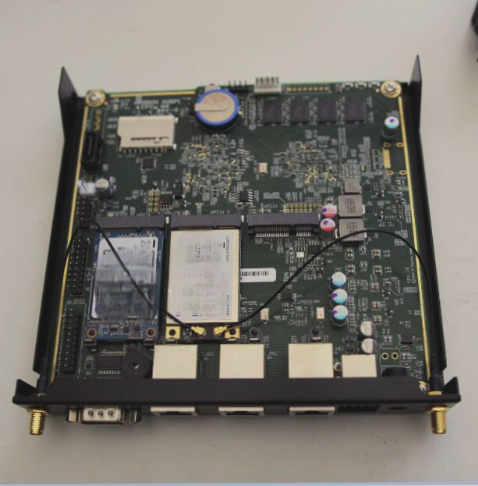The primary objective of PCB surface treatment is to ensure optimal solderability and electrical performance. Natural copper typically oxidizes when exposed to air, making it challenging to maintain in its original form for extended periods. Consequently, additional treatments for copper are essential.
1. Hot Air Leveling (Tin Spraying)
Hot air leveling, commonly referred to as hot air solder leveling (or tin spraying), involves applying molten tin (or lead) solder to the PCB surface and using heated compressed air to flatten and form a protective layer that resists copper oxidation. This process also enhances solderability. During hot air leveling, an intermetallic compound of copper and tin forms at the joint. For effective leveling, the PCB must be immersed in molten solder, and an air knife blows across the liquid solder before it solidifies. This technique helps reduce the meniscus of solder on the copper surface, preventing solder bridging.
Lead Spray Tin:
Lead spray tin is cost-effective and offers excellent welding performance, as well as superior mechanical strength and brightness compared to lead-free alternatives. However, due to the presence of heavy metals like lead, it is not environmentally friendly and does not comply with ROHS regulations.
Lead-Free Tin Spray:
While lead-free tin spray is also affordable, it tends to have a duller appearance compared to lead-based options. Nevertheless, it is environmentally friendly and meets ROHS standards.
—
Let me know if you need any further adjustments!

1. Common disadvantage: This method is not suitable for soldering pins with fine gaps or overly small components due to the poor surface flatness of the spray tin plate. Solder beads can easily form during PCB processing, potentially causing short circuits with fine pitch components. In double-sided SMT processes, the second side undergoes high-temperature reflow soldering, which can lead to the spraying of tin and re-melting, creating tin beads or droplets that, under gravity, may form spherical tin dots, further compromising surface flatness and soldering quality.
2. Organic Solderability Preservative (OSP): OSP is a surface treatment process for printed circuit board (PCB) copper foil that complies with RoHS directives. The term OSP stands for Organic Solderability Preservatives, also known as Copper Protector or Preflux in English. Essentially, OSP involves chemically growing an organic film on a clean bare copper surface. This film offers anti-oxidation, thermal shock resistance, and moisture protection to prevent rust (oxidation or sulfidation) in normal conditions; however, during subsequent high-temperature soldering, this protective layer is quickly removed by flux, allowing the exposed copper to bond with molten solder, forming a strong joint rapidly.
3. Whole plate nickel-plated gold: The process involves plating a layer of nickel followed by a layer of gold on the PCB surface conductors. Nickel plating primarily prevents diffusion between gold and copper. There are currently two types of electroplated nickel gold: soft gold plating (pure gold with a less shiny surface) and hard gold plating (smooth, hard, and wear-resistant, containing cobalt and other elements, giving it a brighter appearance). Soft gold is mainly utilized for gold wire during chip packaging, while hard gold is used for electrical interconnections in non-welded areas.
4. Immersion gold: Immersion gold creates a thick, durable nickel-gold alloy on the copper surface, providing long-lasting protection for the PCB. It exhibits environmental resilience that other surface treatments may lack. Additionally, immersion gold prevents copper dissolution, benefiting lead-free assembly. Advantages include resistance to oxidation, long storage life, and a flat surface, making it suitable for welding small gap pins and components with fine solder joints, especially on PCBs with buttons (e.g., mobile phone boards). It can withstand multiple reflow soldering cycles without degrading solderability and can serve as a substrate for COB (Chip On Board) wire bonding.
5. Shen Xi: As all current solders are tin-based, the tin layer can effectively match any solder type. The tin sinking process facilitates the formation of a flat copper-tin intermetallic compound, providing the same solderability benefits as hot air leveling without the flatness issues associated with that method. However, tin plates should not be stored for extended periods, and assembly must occur promptly following the tin sinking process.
6. Immersion silver: The immersion silver process is positioned between organic coatings and electroless nickel/immersion gold. This method is relatively straightforward and quick; even when exposed to heat, humidity, and contaminants, silver maintains good solderability but may lose its shine. Unlike electroless nickel/immersion gold, immersion silver lacks strong physical properties due to the absence of nickel beneath the silver layer.
7. Chemical nickel palladium gold: Compared to immersion gold, chemical nickel palladium gold includes an additional layer of palladium between nickel and gold. Palladium acts as a corrosion barrier from substitution reactions, ensuring optimal conditions for immersion gold application. Gold is tightly adhered to palladium, providing a reliable contact surface.
8. Plating hard gold: To enhance wear resistance and increase the durability of PCB products, hard gold plating is employed.



